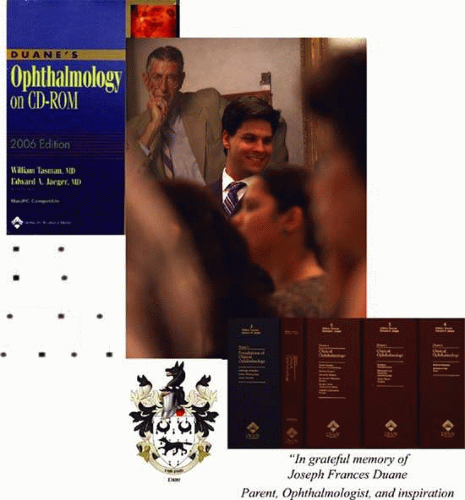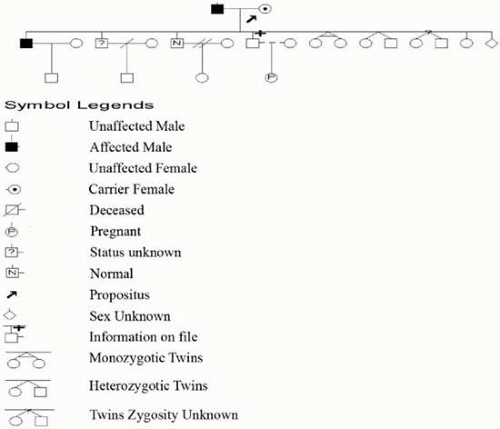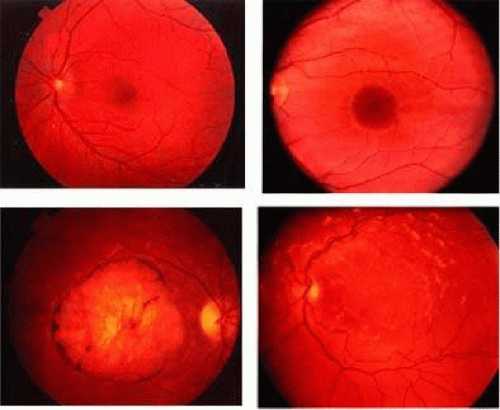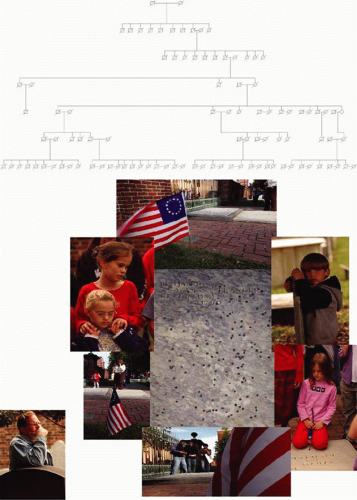Principles of Genealogical Research and Practical Applications to Eye Disease
Tara Uhler
Tamara Vrabec
Arcilee Frost
Larry A. Donoso
Introduction
Background/History
The study of ancestry or families, genealogy, is a common thread throughout the history of mankind and affords people a sense of belonging and continuity. For many reasons and in many forms, genealogy has played an important role in cultures around the world since ancient times.1 For example, in order to obtain high social status, Greeks studied genealogy as a means of proving descent from a god or goddess. In the Old Testament, begat is a common word, and entire sections are devoted to establishing lines of lineage in painstaking detail. Christian monks kept pedigrees of royal family members and linked them to the genealogies outlined in the scriptures. Englishmen used it to prove nobility in order to obtain knighthood. Crusaders adopted surnames, families adopted coats of arm, and Alaskan natives carved Totem poles.1 Pictures, books and records, crests, and the like have all been useful in the study of genealogy (Fig. 50.1). More recently the task of genealogical recording has been made easier by sophisticated computer programs (Fig. 50.2) and Internet access to the World Wide Web (www). A practical list of informative Web sites related to genealogy is given at the end of the chapter and are shown in blue as is common in referring to a URL (uniform resource locator) or Web site.
In addition to being an increasingly popular hobby, genealogy has been used to resolve legal disputes, and combined with molecular genetics, to solve crimes or identify victims of natural disasters.2,3,4,5,6,7,8 Using DNA evidence to solve crimes even years after they are committed is commonplace today. In addition to conclusively convicting criminals, DNA evidence is also used to defend wrongly accused individuals. For example, Project Innocence established in 1992 is dedicated to exonerating the innocent through postconviction DNA testing. Through such efforts many convictions have been overturned or reaffirmed with genetic evidence.9,10,11,12,13,14
A fascinating example of the use of this technology is the Romanov mystery (Fig. 50.3). Tsar Nicholas II the son of Alexander III began his rein in 1894. During a period of civil unrest, the working class and public opinion turned against him. On July 17, 1918, nine members of the royal family (Tsar Nicholas II, Tsarina Alexandra, Tsarevich Alexis; and Grand Duchesses Olga, Tatiana, Maria, and Anastasia) were executed along with one doctor and three servants. In 1991, DNA evidence from a mass grave presumed to be the remains of the executed Czar Nicholas Romanov II and his family was compared with samples from the exhumed bones of Czar Nicholas’s brother and from living relatives identified through royal family trees. In this way, the remains of former Russian Czar Nicholas Romanov II and his family were positively and conclusively verified almost 80 years after their executions (Table 50.1). Similarly, claims to be his descendants, Alexis and Anastasia, have been refuted using this DNA evidence,15,16,17,18,19,20,21,22,23,24,25,26,27,28,29,30 preserving, in principle, a potential large inheritance and position in the Royal family tree.
Table 50.1 Genetic identification of the nine exhumed bodies | ||||||||||||||||||
|---|---|---|---|---|---|---|---|---|---|---|---|---|---|---|---|---|---|---|
| ||||||||||||||||||
Genealogy in Medicine
Perhaps, one of the most exciting uses of genealogy has been its role in solving medical mysteries. One of the first uses of genealogy in medicine was the discovery that alkaptonuria was inherited. In 1902, Archibald Garrod, an English physician, noticed the parents of children with alkaptonuria were often first cousins, and he suggested the disease might be inherited. This was the first description of a Mendelian recessive trait in man.31,32,33,34,35,36,37,38,39,40,41,42,43,44
Since Garrod’s remarkable observation in humans, a large number of genes, including alkaptonuria, have been identified. However, the etiology of some more common diseases like adult onset macular degeneration appears more complicated. This may be, in part, to the disorder being multifactorial in origin. Here, multiple genes may exert effects and be influenced as well by environmental factors, other genes, and variables yet unknown. This may explain variations in clinical presentation, severity, rate of progression, and response to different treatments of some diseases like breast cancer.45,46,47
In medicine, genealogy provides the opportunity to study both common and rare diseases more closely and potentially better treat, prevent, or prepare for illness. This is a powerful concept. The ability to predict who might suffer from a specific illness affords physicians and patients the opportunity to intervene earlier and tailor a treatment regimen to the individual’s genetic make-up and predisposition. Prevention or slowing of disease progression is the holy grail of medicine. Genealogy is an important tool for attaining this lofty goal.
Combining genealogy and molecular genetics, researchers can identify the different genes involved in specific disease states. Subsequently, improved understanding of pathogenesis and development of specific therapeutic targets offer better treatment options with fewer side effects. Individuals at risk for a certain illness may be identified earlier. The severity or prognosis and specific variations of a disease with a broad clinical spectrum may be better understood on a case-by-case basis. Armed with this kind of knowledge and proper genetic counseling, patients and physicians may make informed choices to start conservative or aggressive treatment options earlier or later and address modifiable risk factors.
In ophthalmology, diagnosis of many conditions relies heavily on pattern recognition. However, clinical variations in the presentation of a single disease and the number of diseases that share similar, overlapping phenotypes can be confusing and make diagnosis difficult. Genealogy of a large family can allow for clinical examination of affected individuals from all age groups and documents the clinical spectrum of a disease over time. Similarly, genealogy may help resolve conflicts in diagnosis when clinical phenotypes of different diseases appear the same or might otherwise be overlooked.48,49,50
For example, Edwards et al.51 characterized dominant Stargardt-like macular dystrophy in two large family consisting of over 300 individuals. Furthermore, many of the family members were not known to be related to each other. Through genealogical investigation, the authors demonstrated both families were related to each other through a common ancestor born in Ireland in 1730. Because of the large size of the family with subjects ranging from age 5 to over 70, it was possible to document the wide range of phenotypic variability seen in this disorder in individuals within a family, and between families over time (Fig. 50.4). Compared to younger subjects, older subjects exhibited more funduscopic changes and a much wider spectrum of changes. The diagnosis would have been very difficult and confusing if the subjects had not been known to be related and to share the same genetic mutation in the ELVOL4 gene.
Types of Genealogy
Individual and Family Genealogy
Genealogical records serve many purposes. Studying them may identify important information about an individual, a family, or a population. Some famous individuals, like Benjamin Franklin, made significant contributions to ophthalmology, and their family tress are readily available on the internet. The genealogy of Benjamin Franklin, a man of great vision, is illustrated in Fig. 50.5. The year 2006 marked the 300th anniversary of Benjamin Franklin’s birth. Well known to ophthalmologists, the inventor of bifocals, Franklin was born in Boston in 1706 and died in Philadelphia in 1790 after a lifetime of incredible innovation, invention, and diplomacy (Table 50.2).
Table 50.2 Chronology of the Life of Benjamin Franklin | ||||||||||||||||||||||||||||||||||
|---|---|---|---|---|---|---|---|---|---|---|---|---|---|---|---|---|---|---|---|---|---|---|---|---|---|---|---|---|---|---|---|---|---|---|
|
Stay updated, free articles. Join our Telegram channel

Full access? Get Clinical Tree








